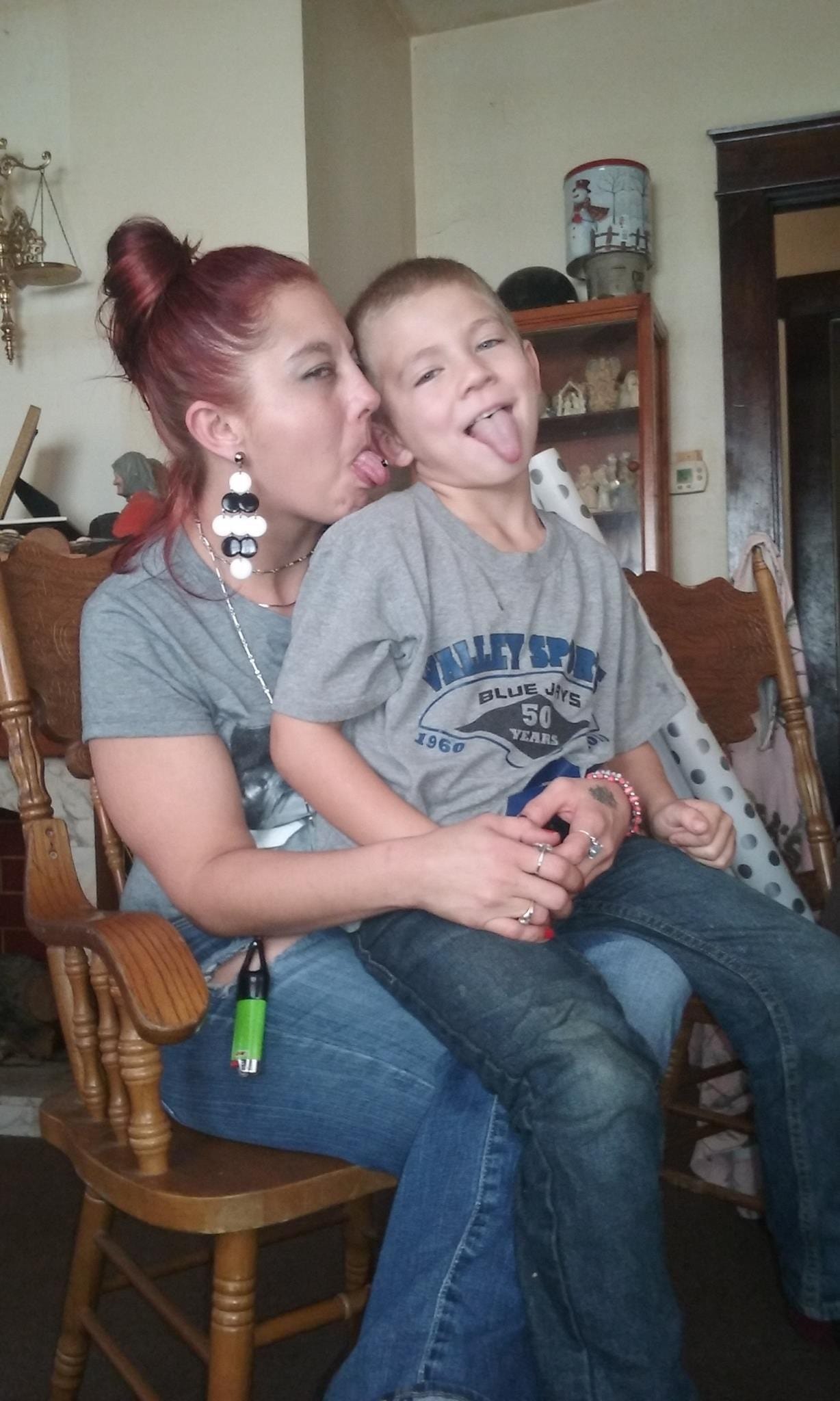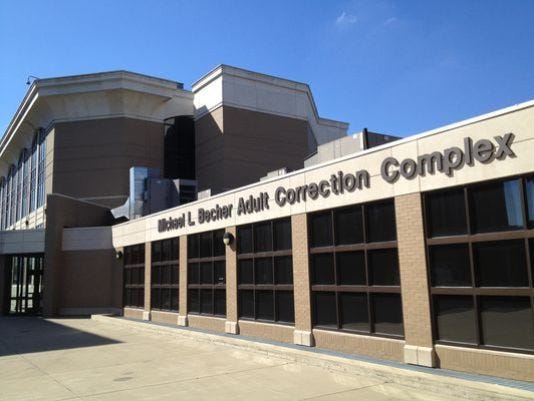This story contains discussion of suicide. If you or someone you know may be struggling with suicidal thoughts, call the suicide prevention hotline at 800-273-8255 or seek out area resources.
Candice Wheat made a chilling confession to the Clarksville police officer driving her to jail.
She wanted to kill herself.
When they arrived at the Clark County Jail, the officer made sure to warn staff about Wheat’s troubling statement. Even so, she wasn’t placed on suicide watch, which would have required in-person checks every 15 minutes.

Instead, the jailer gave her a suicide smock and directed Wheat to remove her clothes. The smock is made of a heavy, tear-resistant material that can’t easily be ripped or used to form a noose.
But the officer was the only woman working in that part of the jail at the time, so she didn't stay in the cell to watch Wheat change. Nor did the jailer retrieve Wheat’s clothing.
Two hours later, Wheat’s body was found slumped on the cell floor. A string attached to the wall-mounted bunk was pulled tightly around her neck.
Outside jail, suicides often happen when a person is alone. But inside jails, people are supposed to be under constant supervision, either in person or on surveillance cameras. Corrections officers also are taught the warning signs. They know, for example, that the risk for suicide is highest shortly after a person is jailed.
Yet an extensive IndyStar review of deaths inside Indiana’s jails found that suicides are occurring with alarming frequency. And it’s not as if the deaths are always happening in darkened cells and concealed corners. On the contrary, many take place in the open, on camera or while a person is on suicide watch.
Corrections experts believe many suicides can be prevented. In truth, they are fueling the epidemic of deaths inside Indiana's county jails.
Lisa Boesky, a California psychologist who often consults with corrections officials, said sheriffs and jails are doing more today than ever before to prevent suicides. Still, she acknowledged, the threat looms large.
"We may not be able to stop all jail suicides," Boesky told IndyStar, "but there is much we can do to reduce it."
Wheat, the Southern Indiana mother of three, was among more than 125 people to die by suicide in county jails across Indiana since 2010, according to an IndyStar review of more than 300 jail deaths.
The IndyStar investigation, “Death Sentence,” found suicide was the leading cause of death in Indiana jails. While that also is true across the U.S., the problem appears to be significantly worse in Indiana. Suicide accounted for 42% of Indiana's jail deaths, according to IndyStar's review of deaths from 2010 through June 30. The national average in 2018 was about 30%, the federal government reported.
IndyStar also discovered that no one at the local or state level in Indiana tracks the details surrounding jail suicides, a process experts say is critical to understanding the issues behind those deaths — and to preventing others in the future.
The yearslong investigation, which provides an in-depth look at the circumstances of suicides inside Indiana jails, reveals basic answers and shocking details that appear to have eluded or been ignored by local and state corrections officials.
The harsh reality of being locked up can be overwhelming. People may fear being fired from their job, embarrassing their families or, like Wheat, losing their children. Others may not be able to cope with the thought of going to prison. And some may feel they’re unable to get by without drugs or alcohol to endure the physical and mental anguish of withdrawal.
Research shows people in jail are more than twice as likely to die by suicide than someone in the general population. That’s why careful evaluation when someone arrives at a jail and close monitoring are so critical.
"The lowest point of anybody's life, that I know of, is being incarcerated," said Nicole Gaunt, a licensed clinical social worker in Fort Wayne. "Fear of the unknown."
Gaunt formerly worked with a married couple whose 18-year-old daughter, Ariona Darling, died by suicide in the Allen County Jail this year.
She thought back to meeting Darling when she was still 14. The young girl had already experienced difficult trauma, but her parents were pushing to help in every way they could.
Now it hurts to realize that the one place where they thought Darling would be safest is the one where she died.
"Behind these jail deaths," Gaunt said, "there is a story."

More people are dying by suicide in Indiana jails because almost every county faces a shortage of drug and mental health treatment options. Without help, many end up in jail instead.
As many as 80% of the roughly 20,000 Hoosiers in Indiana’s county jails are struggling with mental health or substance use issues, said Hendricks County Sheriff Brett Clark, president of the Indiana Sheriffs’ Association.
The two often go hand-in-hand, he said.
As a result, sheriffs and jailers are dealing with a growing number of people experiencing mental crises, addiction and gut-wrenching withdrawal symptoms. They present a heightened risk for suicide. Some require near-constant attention. It's not what jails were intended for or designed to deal with, and many sheriffs told IndyStar they are not adequately equipped or funded for the new role.
"We have some training in mental health, yes, but we are not trained like a mental health facility," Adams County Sheriff Dan Mawhorr said. "And that's where we need help."
The situation is further compounded, IndyStar found, by widespread overcrowding and staff shortages. IndyStar’s investigation found that 84% of Indiana’s jails are routinely over capacity, understaffed or both.
That includes the Clark County Jail, where Wheat died by suicide. The jail failed to meet the state’s safety standards in seven of the last 11 years, dating back to 2010, IndyStar found. And it was overcrowded for 10 of those years.
When jails are overcrowded, it can be hard to segregate those who require a heightened level of attention. And when jails are understaffed, officers have less time to monitor people — whether in person or by surveillance cameras.
The staffing issue goes beyond just having enough bodies to run a jail. There’s also a shortage of workers in jails with the training or expertise to care for the huge influx of physically and emotionally fragile individuals. Boesky, the suicide expert who works with corrections facilities, said jails need to hire an adequate number of qualified mental health professionals. But they can only do so much.
Inside jails, IndyStar found, mental health services vary widely in jails across the state. While some jails have full-time counselors available, many others have professionals who visit only a few hours a week. Some jails have none at all.
In the long run, Boesky said, the work of identifying, referring, supporting and responding to suicidal inmates often falls to jail officers. And they need "high-quality, practical suicide prevention training tailored to non-clinical staff working in a jail setting," she said. They also require supervision to ensure they implement what they learned in training.
In Indiana, though, new corrections officers are required to attend only eight hours of state-mandated training specifically focused on suicide and mental health. State law also allows them to work as long as a year before receiving that training.
The challenges tied to drugs, mental illness and a lack of training show up over and over in the suicides identified by IndyStar: Warning signs missed, threats not taken seriously, and the failure to make timely in-person checks. The investigation also found several cases where no one working at a jail intervened after surveillance cameras captured people in their cells fashioning makeshift nooses or making other preparations to harm themselves.

Joshua Eckert was given a medical assessment at the Huntington County Jail when he was booked on a misdemeanor marijuana charge in 2013. Eckert, 33, told the jailer he had bipolar disorder. He also revealed a history of suicide attempts and said he might become suicidal in jail.
He asked about getting the psychiatric medications he'd been prescribed. His girlfriend offered to bring his medicine to the jail, but was told they had to be approved by the jail's medical provider.
Six days later, during a follow-up medical assessment, Eckert again said he had attempted suicide in the past and might become suicidal in jail. After returning to his cell in the general population, Eckert cut his wrists. He received treatment at a local hospital. When jailers brought him back to jail, they placed him on suicide watch.
The next day, the jail requested Eckert's medical records and his psychiatric prescriptions. That same day an officer noted Eckert was "acting strange" as he was held alone on suicide watch in a cell with a window and surveillance camera.
Eckert's mother, Julie Marsh, later watched the video recorded on that camera. It showed her son grasping a suicide blanket, made of a fabric that is supposed to be tear-resistant. Still, somehow he's shown methodically shredding pieces away. She struggles with what she saw. And she wonders why no one stopped him.
"He even put the noose part over the security camera. I mean, my attorney had it all on video," she said. "When he was on his medication, he was fine. But when they wouldn't let him have it, that's when everything kind of went bad."
Despite a policy that called for "continuous uninterrupted observation" of suicidal inmates, according to a lawsuit filed in Eckert's death, no one seemed to notice or intervene.
The Huntington County Jail was chronically overcrowded, including in 2013, when Eckert died. It also fell short of the state's safety standards for crowding or staffing in eight of the 11 years examined by IndyStar — including in 2013, when Eckert died.
Sitting in his cell, Eckert was recorded on camera tying "blanket fabric around his neck." Then he disappeared from the camera's view.
Twelve minutes later, a jailer found Eckert hanging from the camera's mount. Eckert was later pronounced dead at a local hospital.
Eckert had used the very tools that were supposed to prevent suicide — tear-resistant fabric and a surveillance camera — to hang himself.
Marsh said what angers her the most about her son's death is that the jail forced him to go without his medications for more than a week. She believes that’s what drove him to take his life.
"He thought that was the only way out," she said.
Two days after Eckert hung himself, according to the lawsuit, the jail received a response from its medical provider regarding the jail's request for Eckert's psychiatric medications.
They finally had been approved.

Lindsay Hayes has researched suicides in jails and prisons for 40 years. He often hears the same question: Who cares?
He believes that question hints at why research and tracking are rarely the priority of federal or state governments, in Indiana or elsewhere.
"My answer has always been and continues to be the same," said Hayes, who has conducted studies for the U.S. Department of Justice and the National Institute of Corrections. "Preserving life is our moral and legal responsibility. Everyone who dies in our jails could have been our son or daughter, our brother or sister, our loved one, our friend."
Finding solutions, he said, requires looking at what happened and asking why. But that is not happening on a comprehensive, system-wide basis in Indiana.
IndyStar found the Indiana Department of Correction, which is responsible for inspecting jails and has the authority to push for changes to improve safety, has for years undercounted the number of people who died in jails.
And when asked by IndyStar how many suicides occurred in Indiana jails from 2010-20, the agency did not even respond.
The Indiana Criminal Justice Institute, a different state agency, published a report this year that went a little further than the IDOC's past reports. The new report, which examined in-custody deaths in 2020, still did not include context and details that experts say would be crucial to any meaningful analysis.
The reports, for example, do not contain additional details on the circumstances of a person's death, such as the timing or how the person specifically died, let alone possible triggers, the role of mental illness or drugs, jail conditions, suicide prevention policies, staffing or training.
Hayes said government officials should be collecting detailed information every year. Without it, there is no way to develop effective prevention strategies to address the issues driving an increase in jail suicides.
"It’s very unfortunate that we can't find out easily available data on the number of people and the types of people and circumstances behind their death in our public facilities," Hayes said.

It was the morning before Mother’s Day when Candice Wheat rode through Clarksville with a friend. A town police officer saw the red vehicle and ran the license plate. The registration came back for a black car, so he pulled it over.
During the traffic stop, Wheat gave the officer permission to search her purse. He found a bag that contained a small pipe and a crystal substance. A field test indicated it was methamphetamine.
The driver was given a traffic citation and released. Wheat was handcuffed and placed in the officer’s squad car for the four-mile trip to Clark County Jail.

Wheat, who had no prior criminal history, broke down. In addition to saying she wanted to "kill herself," the officer wrote in an arrest report, she feared she would lose her kids.
Sherry Clifford told IndyStar that her sister's arrest was likely the final straw in a series of events that had left Wheat struggling emotionally. She had battled depression since her grandmother died in 2010. Then a divorce sparked a custody battle. Then her brother died in 2015.
Wheat had recently started seeing a therapist.
During the book-in process, video recorded a jailer following up on the police officer's warning. The jailer asked medical questions. One of them was whether Wheat felt like harming herself.
Wheat offered a confusing response: "I feel like, whether I do it or not is not true," a state police report said.
The jailer locked Wheat into a holding cell outfitted with a motion-activated surveillance camera at 9:22 a.m. Had officers placed Wheat on suicide watch, they would have been required to check on her every 15 minutes.
Instead, the jailer handed Wheat a suicide smock and walked away. Because she was the only officer working in that part of the jail at the time, she said she was unable to stay in the cell to make sure Wheat changed into the protective smock. She also left Wheat's clothing behind.
Video from the cell showed Wheat removing her clothes as ordered. She folded and placed them on a bunk. Then she tried to put on the smock several times, "finally just wrapping it around herself," the state police report said.

At 10:09 a.m., motion in the cell activated the camera. Wheat was up, but stumbling. Then she fell down. She got up and fell again.
The camera activated again at 11:06 a.m. It captured Wheat falling from the metal bed mounted to the wall. Something was wrapped around her neck.
Forty more minutes passed before the camera came back on as the officer entered Wheat’s cell. She struggled to remove the string from Wheat’s neck, then she started CPR. Other officers soon arrived, trying to resuscitate Wheat.
In an email to IndyStar, the Clark County Sheriff's Office said officers checked Wheat six times before they found her body.
The family's lawsuit was resolved with a $500,000 settlement. The money will help provide for Wheat’s children, but is little consolation for her family.
"It could have definitely been prevented if they was doing their job," Clifford said. "If they would have just did a few small things like make sure she got her clothes taken from her, made sure that she was checked every 15 minutes."
Instead, every Mother’s Day revives the painful memories. The loss of a sister and daughter. Three children left without a mother.
Contact Tim Evans at 317-444-6204 or tim.evans@indystar.com. Follow him on Twitter: @starwatchtim.
Contact IndyStar investigative reporter Ryan Martin at ryan.martin@indystar.com or by phone, Signal or WhatsApp at 317-500-4897. Follow him on Facebook or Twitter: @ryanmartin.
"occur" - Google News
October 13, 2021 at 08:12AM
https://ift.tt/3aw64uG
Suicide in jails: Why preventable deaths occur at alarming rate in Indiana - IndyStar
"occur" - Google News
https://ift.tt/2UoDqVw
https://ift.tt/2Wq6qvt
Bagikan Berita Ini
















0 Response to "Suicide in jails: Why preventable deaths occur at alarming rate in Indiana - IndyStar"
Post a Comment